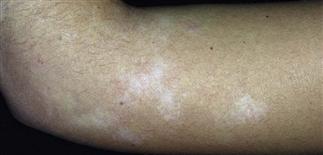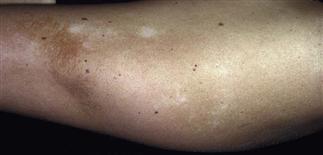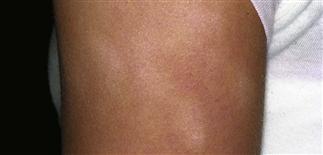23
Pityriasis alba

Hypopigmented macules and patches on the extensor arm. This child is atopic. There was no preceding inflammation evident, as is typical of pityriasis alba.

Hypopigmented macules and patches on the extensor upper arm. These lesions are asymptomatic; the patient often seeks advice due to cosmesis.

Pityriasis alba can be very subtle. It is commonly located on the lateral cheeks and upper arms in children and young adults. Atopic eczema may be present elsewhere.

Hypopigmented macules, differential diagnosis includes pityriasis alba, tinea versicolor, postinflammatory hypopigmentation, vitiligo, and rarely hypopigmented cutaneous T-cell lymphoma.
DESCRIPTION
Asymptomatic, hypopigmented, fine scaling patches with indistinct borders, typically on the lateral cheeks. Affects the lateral cheeks, lateral upper arms, and thighs. Occurs more frequently in young children and usually resolves by early adulthood.
HISTORY
• Pityriasis alba is asymptomatic. • Children and young adults are affected. • No history of prior rash, trauma, or inflammation. • Affected individuals are often atopic. • Loss of pigment is often more noticeable and distressing in darkly pigmented people.
PHYSICAL FINDINGS
• White macules and patches are round to oval and vary in size; they are generally 2–4 cm in diameter. • A fine surface scale may be seen on close inspection. • Lesions are most common on the lateral cheeks, lateral upper arms, and thighs. • Condition more obvious in the summer and in darker skin types, when affected skin does not tan.
TREATMENT
• Usually no treatment is recommended, as the problem is benign and self-resolving. Emollient use every day may help. • Reassure the patient that the loss of pigment is not permanent. • Hypopigmentation usually fades with time. • Hydrocortisone cream or ointment 1% applied for a limited time (a few weeks) on affected skin may help patients who are most distressed by the pigment irregularity.







